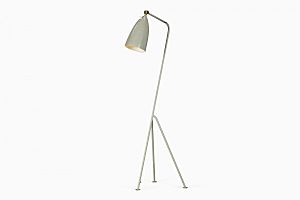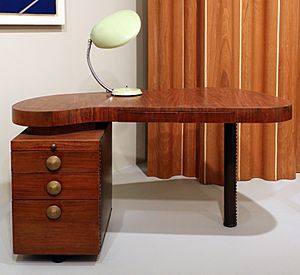Greta Magnusson-Grossman facts for kids
Greta Magnusson-Grossman (born July 21, 1906 – died August 1999) was a talented Swedish designer and architect. She was one of the few women who became famous in the world of architecture in Los Angeles during the mid-1900s. Her early experiences with European Modernism, a style of design, greatly shaped her later work. She blended European ideas with the culture and lifestyle of Southern California.
Early Life and Education
Greta Magnusson was born on July 21, 1906, in Helsingborg, Sweden. Her family had a history of being cabinetmakers. After finishing school, she became an apprentice at a furniture company called Kärnans in Helsingborg. She was the only woman in the workshop at that time. Greta knew it was harder for women artists, so she felt she always had to be "a step ahead."
In 1928, Greta went to study Furniture Design at Konstfack in Stockholm. Later, she also studied architecture at the Royal Academy of Technology in Stockholm.
In 1933, she won an award for Furniture Design from the Swedish Society of Industrial Design. She was the first woman to ever win this award. In the same year, she married Billy Grossman, a British jazz musician. They did not have any children.
Starting Her Career
In 1933, Greta Magnusson-Grossman won second prize in a furniture competition in Stockholm. This made her the first woman to win in that competition.
Soon after, she opened her own company called "Studio" in Stureplan in Stockholm. There, she designed and made her own furniture and other items.
Designing in Los Angeles
In 1940, Greta and her husband moved to Los Angeles during World War II. They opened the Magnussen-Grossman Studio on Rodeo Drive. Their studio focused on designing furniture and lights. They sold their designs to famous furniture companies. Her furniture was known for mixing different materials and having slim, elegant shapes.
Many Hollywood stars liked her work. She designed the interiors of homes for famous actors like Greta Garbo and Ingrid Bergman.
Through the 1960s, Greta was an important person in the world of modern architecture. She was inspired by European designers and the Bauhaus school of design. In 1943, she designed a house in Beverly Hills. This was her first project where she was both the interior designer and the architect. This house was a big success for her and was shown in a famous magazine called Arts & Architecture.
Her houses were usually smaller, about 1,500 square feet. She carefully built them using materials like wood and glass. Her designs were similar to other European architects who moved to California, like Rudolph Schindler and Richard Neutra. Her homes also had the open, airy feel of houses designed for the Case Study program.
Between 1949 and 1959, she designed fourteen houses in Los Angeles. Greta Grossman became known for building homes on "difficult plots" of land. These were often small lots on hillsides. She also worked with other important designers in Southern California.
Out of her sixteen built projects, fourteen houses were in Los Angeles, one was in San Francisco, and one was in her home country of Sweden.
In 1950, the Museum of Modern Art (MoMA) gave Greta Grossman an award for her Cobra lamp.
Greta Grossman also taught Furniture Design at UCLA from 1957 to 1963.
Her Legacy
In 1966, Greta Grossman stopped working as an architect in Los Angeles. She moved with her husband to a house she designed in Encinitas, north of San Diego. She spent the last 30 years of her life painting landscapes and living a quiet life.
In 2010, an exhibition of her work was held in Stockholm. In 2012, another exhibition in Pasadena showed her work from her entire career for the first time. Many of the homes she designed have been torn down, but about ten still exist. These include the Hurley House and the Jim Backus House. In 2012, one of her lamps sold for $37,500 at an auction. This was a record price for her furniture pieces.
In 1999, a company called R 20th Century was making a catalog of Greta Grossman's work. They found out about her work through a famous architectural photographer, Julius Shulman, who had taken pictures of her designs in the 1940s and 1950s. This helped the company find and record much of her work.
Greta Magnusson-Grossman died in August 1999.
See also
 In Spanish: Greta Magnusson-Grossman para niños
In Spanish: Greta Magnusson-Grossman para niños




